Albatros D.V
| Albatros D.V | |
|---|---|
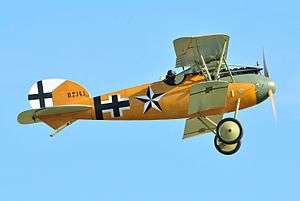 | |
| Albatros D.Va reproduction at Duxford Air Show, 2012 | |
| Role | Fighter |
| Manufacturer | Albatros-Flugzeugwerke |
| Designer | Robert Thelen |
| First flight | April 1917 |
| Primary user | Luftstreitkräfte |
| Number built | approximately 2,500 |
The Albatros D.V was a fighter aircraft used by the Luftstreitkräfte (Imperial German Air Service) during World War I. The D.V was the final development of the Albatros D.I family, and the last Albatros fighter to see operational service. Despite its well-known shortcomings and general obsolescence, approximately 900 D.V and 1,612 D.Va aircraft were built before production halted in early 1918. The D.Va continued in operational service until the end of the war.
Design and development
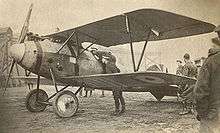
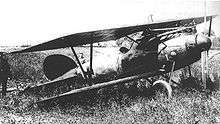
In April 1917, Albatros received an order from the Idflieg (Inspektion der Fliegertruppen) for an improved version of the D.III. The resulting D.V prototype flew later that month. The D.V closely resembled the D.III and used the same 127 kW (170 hp) Mercedes D.IIIa engine. The most notable difference was a new, fully elliptical cross-section fuselage which was 32 kg (71 lb) lighter than the partially flat-sided fuselage of the earlier D.I through D.III designs.[1] The new elliptical cross-section required an additional longeron on each side of the fuselage and the fin, rudder and tailplane initially remained unchanged from the D.III.[1] The prototype D.V retained the standard rudder of the Johannisthal-built D.III but production examples used the enlarged rudder featured on D.IIIs built by Ostdeutsche Albatros Werke (OAW).[2] The D.V also featured a larger spinner and ventral fin.
Compared to the D.III, the upper wing of the D.V was 121 mm (4.75 in) closer to the fuselage, while the lower wings attached to the fuselage without a fairing. The D.V wings were almost identical to those of the standard D.III, which had adopted a sesquiplane wing arrangement broadly similar to the French Nieuport 11. The only significant difference between wings of the D.III and D.V was a revised routing of the aileron cables that placed them entirely within the upper wing.[3] Idflieg conducted structural tests on the fuselage but not the wings of the D.V.[4]
Early examples of the D.V featured a large headrest, which was usually removed in service because it interfered with the pilot's field of view.[3] The headrest was deleted from the second production batch.[5] Aircraft deployed in Palestine used two wing radiators, to cope with the warmer climate.
Idflieg issued production contracts for 200 D.V aircraft in April 1917, followed by additional orders of 400 in May and 300 in July.[4] Initial production of the D.V was exclusively undertaken by the Johannisthal factory, while the Schneidemühl factory produced the D.III through the remainder of 1917.
Operational history
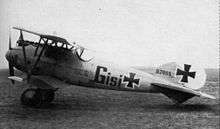
The D.V entered service in May 1917 and structural failures of the lower wing immediately occurred.[4] In 2009, Guttman wrote that "Within the month Idflieg was doing belated stress testing and concluding, to its dismay, that the D V’s sesquiplane wing layout was even more vulnerable than that of its predecessor".[6] The outboard sections of the D.V upper wing also suffered failures, requiring additional wire bracing, and the fuselage sometimes cracked during rough landings.[6]
Against these problems, the D.V offered very little improvement in performance.[3][4] Front line pilots were considerably dismayed and many preferred the older D.III; Manfred von Richthofen was particularly critical of the new aircraft. In a July 1917 letter, he described the D.V as "so obsolete and so ridiculously inferior to the English that one can't do anything with this aircraft". British tests of a captured D.V revealed that the aircraft was slow to manoeuvre, heavy on the controls and tiring to fly.[7]
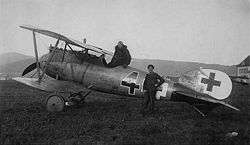
Albatros responded with the D.Va, which featured stronger wing spars, heavier wing ribs and a reinforced fuselage.[8] The modified D.Va was 23 kg (51 lb) heavier than the D.III but the structural problems were not entirely cured. Use of the high-compression 130 kW (180 hp) Mercedes D.IIIaü engine offset the increased weight of the D.Va.[9] The D.Va also reverted to the D.III aileron cable linkage, running outwards through the lower wing, then upwards to the ailerons to provide a more positive control response. The wings of the D.III and D.Va were interchangeable.[3] To further strengthen the wing, the D.Va added a small diagonal brace connecting the forward interplane strut to the leading edge of the lower wing; the brace was also retrofitted to some D.Vs.[9]
Idflieg placed orders for 262 D.Va aircraft in August 1917, followed by orders for another 250 in September and 550 in October. Ostdeutsche Albatros Werke, which had been engaged in production of the D.III, received orders for 600 D.Va aircraft in October. Deliveries of the D.Va commenced in October 1917.[8] The structural problems of the Fokker Dr.I and the mediocre performance of the Pfalz D.III left the Luftstreitkräfte with no alternative to the D.Va until the Fokker D.VII entered service in mid-1918. Production of the D.Va ceased in April 1918.[10] In May 1918, 131 D.V and 928 D.Va aircraft were in service on the Western Front; the numbers declined as the Fokker D.VII and other types replaced the Albatros in the final months of the war. By 31 August, fewer than 400 Albatros fighters of all types remained at the front but they continued in service until the Armistice.[11]
Survivors and reproductions
Two D.Va aircraft survive in museums.

- It is believed serial D.7161/17 served with Jasta 46 before being captured sometime in April or May 1918. In 1919, the aircraft was presented to the De Young Memorial Museum in San Francisco, California. The National Air and Space Museum acquired the aircraft in 1949. It was placed in storage until restoration began in 1977. Since 1979, D.7161/17 has been on display at the Air and Space Museum, in Washington D.C. This aircraft carries the distinctive personal marking of "Stropp" on the fuselage sides.
- Serial D.5390/17 was shot down during a fight with an Australian Flying Corps R.E.8 on 17 December 1917. It landed intact behind the lines of the 21st Infantry Battalion of the Second Australian Division, AIF. The unit recovered the aircraft and took the pilot, Leutnant Rudolf Clausz of Jasta 29, prisoner.[12] In February 1918, the War Office ceded D.5390/17 to the AFC as a war trophy. It was eventually put on display at the Australian War Memorial.[12] The aircraft was removed from display in 2001 and underwent extensive restoration at the Treloar Technology Centre.[13] In 2008, D.5390/17 returned to public display at the AWM's ANZAC Hall in Canberra.
- A small number of Albatros D.Va reproductions have been built or acquired; the Royal Air Force Museum in Colindale, London, has a replica in Hangar 2 (previously the Grahame White Factory), Old Rhinebeck Aerodrome (in Bavarian ace Hans Böhning's Rautenflagge] colour scheme for its rear fuselage.)[14][lower-alpha 1] and Kermit Weeks' Fantasy of Flight.
Operators
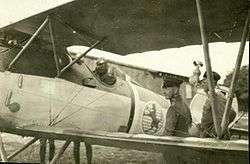
- Polish Air Force (postwar)
Specifications (D.V)

Data from German Aircraft of the First World War[15]
General characteristics
- Crew: 1
- Length: 7.33 m (24 ft 1 in)
- Wingspan: 9.05 m (29 ft 8 in)
- Height: 2.7 m (8 ft 10 in)
- Wing area: 21.2 m2 (228 sq ft)
- Empty weight: 687 kg (1,515 lb)
- Gross weight: 937 kg (2,066 lb)
- Powerplant: 1 × Mercedes D.IIIaü piston engine, 150 kW (200 hp)
- Propellers: 2-bladed wooden propeller
Performance
- Maximum speed: 186 km/h (116 mph; 100 kn)
- Endurance: 350 km
- Service ceiling: 5,700 m (18,700 ft)
- Rate of climb: 4.17 m/s (821 ft/min)
- Time to altitude: 1,000 m (3,281 ft) in 4 minutes
Armament
- Guns: 2 × 7.92 mm (0.312 in) LMG 08/15 machine guns
Gallery
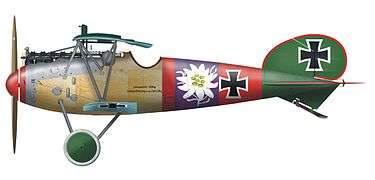 Albatros D.V, Jagdstaffel 5, flown by Paul Bäumer
Albatros D.V, Jagdstaffel 5, flown by Paul Bäumer Albatros D.V, Jagdstaffel 15, flown by Leutnant Walter Dingel, early 1918
Albatros D.V, Jagdstaffel 15, flown by Leutnant Walter Dingel, early 1918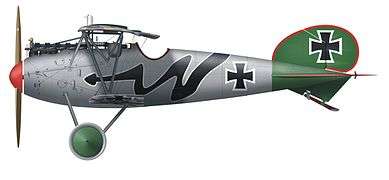 Albatros D.Va, Jagdstaffel 5, flown by Hans von Hippel
Albatros D.Va, Jagdstaffel 5, flown by Hans von Hippel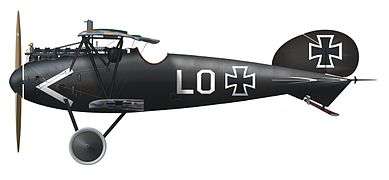 Albatros D.Va, Jasta 37, flown by Ernst Udet
Albatros D.Va, Jasta 37, flown by Ernst Udet Albatros D.V, Jagdgeschwader 1, flown by Manfred von Richthofen.
Albatros D.V, Jagdgeschwader 1, flown by Manfred von Richthofen.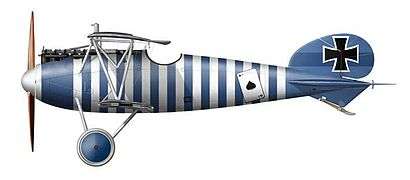 Albatros D.Va, Jasta 79b, flown by Leutnant Hans Böhning, early 1918
Albatros D.Va, Jasta 79b, flown by Leutnant Hans Böhning, early 1918
See also
Related lists
Notes
- ↑ In 2013 the Albatros entered the shop for restoration, where the decision was made to change the livery for the first time. The aircraft was repainted in the brilliant colours of the D.V/D.Va flown by Lt. Hans Böhning of Jagdstaffel 36/Jagdstaffel 76 and returned to the air in May 2014.
References
- 1 2 Mikesh 1980, p. 15.
- ↑ Grosz 2003, pp. 21–22.
- 1 2 3 4 Connors 1981, p. 22.
- 1 2 3 4 Van Wyngarden 2007, p. 40.
- ↑ Guttman 2009, p. 31.
- 1 2 Guttman 2009, p. 22.
- ↑ Bennett 2006, p. 124.
- 1 2 Van Wyngarden 2007, p. 65.
- 1 2 Mikesh 1980, p. 17.
- ↑ Mikesh 1980, p. 7.
- ↑ Herris 2001, p. 154.
- 1 2 "Albatros D.Va Scout Aircraft." Australian War Memorial. Retrieved: 20 July 2017.
- ↑ "Conservation of the Albatros D.Va." Australian War Memorial. Retrieved: 21 July 2017.
- ↑ "Albatros D.Va - Old Rhinebeck Aerodrome". oldrhinebeck.org. Old Rhinebeck Aerodrome. 2014. Archived from the original on November 10, 2014. Retrieved August 9, 2017.
- ↑ Gray and Thetford 1970, p. 52.
Bibliography
- Bennett, Leon. Gunning for the Red Baron. College Station, Texas: Texas A&M University Press, 2006. ISBN 1-58544-507-X.
- Connors, John F. Albatros Fighters in Action (Aircraft No. 46). Carrollton, Texas: Squadron/Signal Publications, Inc., 1981. ISBN 0-89747-115-6.
- Gray, Peter and Owen Thetford. German Aircraft of the First World War. London: Putnam & Company Ltd., 1970. 2nd ed. ISBN 0-370-00103-6.
- Green, William and Gordon Swanborough. The Complete Book of Fighters. London: Salamander Books, 1994. ISBN 0-8317-3939-8.
- Grosz, Peter M. Albatros D.III (Windsock Datafile Special). Berkhamsted, Herts, UK: Albatros Publications, 2003. ISBN 1-902207-62-9.
- Guttman, Jon. SE 5A vs Albatros D V: Western Front 1917-18 (Duel 20). Oxford, UK: Osprey Publishing, 2009. ISBN 978-1-84603-471-8.
- Herris, Jack. Pfalz Aircraft of World War I (Great War Aircraft in Profile, Volume 4). Boulder, Colorado: Flying Machine Press, 2001. ISBN 1-891268-15-5.
- Mikesh, Robert C. Albatros D.Va: German Fighter of World War I. Washington, D.C.: Smithsonian Institution Press, 1980. ISBN 0-87474-633-7
- VanWyngarden, Greg. Albatros Aces of World War I Part 2 (Aircraft of the Aces No. 77). Oxford, UK: Osprey Publishing, 2007. ISBN 1-84603-179-6.
External links
| Wikimedia Commons has media related to Albatros D.V. |